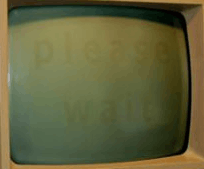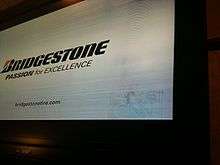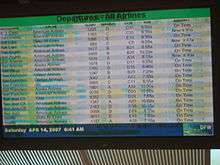Screen burn-in
Screen burn-in, image burn-in, or ghost image, colloquially known as screen burn or ghosting, is a discoloration of areas on an electronic display such as a CRT display or an old computer monitor or television set caused by cumulative non-uniform use of the pixels.

Newer liquid-crystal displays may suffer from a phenomenon called image persistence instead, which is not permanent.
Causes of screen burn
With phosphor-based electronic displays (for example CRT-type computer monitors or plasma displays), non-uniform use of pixels, such as prolonged display of non-moving images (text or graphics), gaming, or certain broadcasts with tickers and flags, can create a permanent ghost-like image of these objects or otherwise degrade image quality. This is because the phosphor compounds which emit light to produce images lose their luminance with use. Uneven use results in uneven light output over time, and in severe cases can create a ghost image of previous content. Even if ghost images are not recognizable, the effects of screen burn are an immediate and continual degradation of image quality.
The length of time required for noticeable screen burn to develop varies due to many factors, ranging from the quality of the phosphors employed, to the degree of non-uniformity of sub-pixel use. It can take as little as only a few weeks for noticeable ghosting to set in, especially if the screen displays a certain image (example: a menu bar at the top or bottom of the screen) constantly, and displays it continually over time. In the rare case when horizontal or vertical deflection circuits fail, all output energy is concentrated to a vertical or horizontal line on the display which causes almost instant screen burn.
CRT
Phosphor burn-in is particularly prevalent with monochromatic CRT screens, such as the amber or green monochrome monitors common on older computer systems and dumb terminal stations. This is partly because those screens displayed mostly non-moving images, and at one intensity: fully on. Yellow screens are more susceptible than either green or white screens because the yellow phosphor is less efficient and thus requires a higher beam current. Color screens, by contrast, use three separate phosphors (red, green, and blue), mixed in varying intensities to achieve specific colors, and in typical usage patterns such as "traditional" TV viewing (non-gaming, non-converged TV usage, non-Internet browsing, broadcasts without tickers or flags, no prolonged or permanent letterboxing) are used for operations where colors and on-screen object placement approach uniformity.
Modern CRT displays are less susceptible than older CRTs prior to the 1960s because they have a layer of aluminum behind the phosphor which offers some protection. The aluminum layer was provided to reflect more light from the phosphor towards the viewer. As a bonus, the aluminum layer also prevented ion burn of the phosphor and the ion trap, common to older monochrome televisions, was no longer required.
Plasma, LCD, and OLED displays


Plasma displays were at one time highly susceptible to burn-in, while LCD-type displays are generally not affected.[1] The wide variation in luminance degradation with RGB-based OLED[2] will cause noticeable color drift over time (where one of the red-green-blue colors becomes more prominent).
In the case of LCDs, the mechanics of burn-in are different than plasma and OLED, which develop burn-in from luminance degradation of the light-emitting pixels. For LCDs, burn-in develops in some cases because pixels permanently lose their ability to return to their relaxed state after a continued static use profile. In most typical usage profiles, this image persistence in LCD is only transient.
Both plasma-type and LCD-type displays exhibit a similar phenomenon called transient image persistence, which is similar to screen burn but is not permanent. In the case of plasma-type displays, transient image persistence is caused by charge build-up in the pixel cells (not cumulative luminance degradation as with burn-in), which can be seen sometimes when a bright image that was set against a dark background is replaced by a dark background only; this image retention is usually released once a typical-brightness image is displayed and does not inhibit the display's typical viewing image quality.
Mitigation
Screensavers derive their name from their original purpose, which was an active method of attempting to stave off screen burn. By ensuring that no pixel or group of pixels was left displaying a static image for extended periods of time, phosphor luminosity was preserved. Modern screensavers can turn off the screen when not in use.
In many cases, the use of a screensaver is impractical. Most plasma-type display manufacturers include methods for reducing the rate of burn-in by moving the image slightly,[3] which does not eliminate screen burn, but can soften the edges of any ghost image that does develop.[4] Similar techniques exist for modern OLED displays. For example, manufacturers of Android Wear watches with OLED displays can request that Android Wear enable "burn protection techniques" that periodically shift the contents of the screen by a few pixels.
Other examples: Apple’s iPhone X and Samsung’s Galaxy series both mitigate or delay the onset of burn-in by shifting the pixels every minute or so and same for the battery, wifi, location, and service bars. Also, parallax scrolling may be enabled for the home screen to give icons a 3D-like effect, a setting Apple refers to as "perspective zoom". AG Neovo patented Anti-burn-in technology is also using pixel shifting to activate the pixels to move by the designed time interval to prevent burn in effect on LCD monitors. [5]
Google requests that when these techniques are enabled, watch face developers do not use large blocks of pixels so that different pixels are burned in with each shift, reducing the overall wear of the pixels.[6]
Some screensavers move around, such as those on DVD players, or those on some televisions that move around paused video after a long period of inactivity.
Depending on the type of screen, it is sometimes possible to remedy screen burn-in through the use of remedial software and remedial devices. In the case of OLED screens on Android phones, burn-in reduction apps can display an inverted image of the navigation and status bars (which are constantly displayed and therefore the most likely elements to be burned in) to burn in opposite pattern, resulting in a screen whose sub-pixels have more even luminosity and therefore less visible burn-in artifacts.[7]
Historical notes
The most prevalent burn-in image on early televisions was said to be that of the RCA Indian-head test pattern, which would often follow the formal television station sign-off. This was due to the viewer leaving the television set on at the end of the day, which was not recommended by the television manufacturers.
References
| Wikimedia Commons has media related to Screen burn-in. |
- Gordon, Whitson. "Is "Burn-In" Still an Issue on TVs and Monitors?". Lifehacker. Retrieved 20 September 2018.
- "DuPont claims OLED record fit for TV apps". EE Times. 12 May 2010. Retrieved 22 April 2012.
- "Plasma TV Screen Burn-In: Is It Still a Problem?". Plasma TV Buying Guide. Retrieved 26 July 2012.
- Plasma TV Features - at the Wayback Machine (archived 21 June 2015)
- "Fix LCD Monitor Burn In Effect – Anti-Burn-in™ Technology". AG Neovo.
- "Watch Faces for Android Wear". Android Developers. Retrieved 15 March 2016.
- AMOLED Burn-in Fixer - Android Apps on Google Play at the Wayback Machine (archived 31 December 2016)